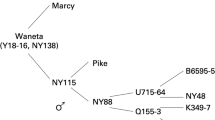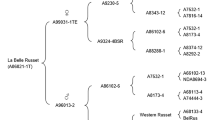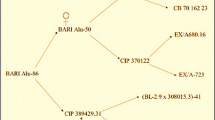Abstract
Willamette (AO91812-1), a high-yielding, round, white-skinned variety with good chipping qualities, was released in 2003 by the Oregon, Idaho and Washington Agricultural Experiment Stations and the US Department of Agriculture–Agricultural Research Service. Willamette was selected at Powell Butte, Oregon in 1993 from a cross between NDA2031-2 and A86463-3. Willamette vines are relatively large, vigorous and medium-late in maturity. Yields of Willamette were higher than Atlantic across a number of western states (total yield: Willamette 60.6 Mg ha−1, Atlantic 50.8 Mg ha−1). Willamette exhibited fewer internal tuber defects than Atlantic tubers (i.e. hollow heart and brown center: Willamette 2.0%, Atlantic 8.7%), but had similar levels of external defects. Willamette chips well from 10°C storage (Willamette chip color 1.4, Atlantic 1.6) but not from 4.4°C. Tuber specific gravity is comparable to that of Atlantic (1.084). Willamette tubers contain slightly lower levels of total glycoalkaloids (Willamette 3.1 mg 100 g−1, Atlantic 6.8 mg 100 g−1) and vitamin C (Willamette 16.4 mg 100 g−1, Atlantic 21.7 mg 100 g−1) than those of Atlantic, but has similar levels of dry matter, protein, dextrose and sucrose. Compared to Atlantic, Willamette shows greater resistance to Verticillium wilt and potato leafroll virus, similar susceptibility to early blight, foliar late blight, Erwinia soft rot and potato virus Y, and greater susceptibility to tuber late blight and common scab.
Resumen
Willamette (AO91812–1), una variedad de alto rendimiento, redonda, de piel blanca, buenas cualidades para hojuelas, fue liberada en 2003, por las Estaciones Experimentales Agrícolas de Oregon, Idaho y Washington y el Servicio de Investigación Agrícola del Departamento de Agricultura de los Estado Unidos. Willamette fue seleccionado en Powell Butte, Oregon en 1993 de un cruzamiento entre NDA2031-2 y A86463-3. Las plantas de Willamette son relativamente grandes, vigorosas de madurez media–tardía. Los rendimientos de Willamette son mas altos que los de ‘Atlantic’ en varios estados del oeste (rendimiento total: Willamette 60.6 Mg ha−1, Atlantic 50.8 Mg ha−1). Willamette tuvo menos defectos internos del tubérculo que Atlantic (ie. Corazón vacío y oscurecimiento central: Willamette 2%, Atlantic 8.7%), pero tuvieron niveles similares de defectos externos. Willamette produce bien hojuelas de papa procedentes de almacenamiento a 10°C (color de hojuelas de Willamette 1.4, Atlantic 1.6), pero no procedentes de 4.4°C. La gravedad específica del tubérculo es comparable a la de Atlantic (1.084). Los tubérculos de Willamette contienen ligeramente menores niveles de glicoalcaloides (Willamette 3.1 mg 100 g−1, Atlantic 6.8 mg 100 g−1) y vitamina C (Willamette 16.4 mg 100 g−1, Atlantic 21.7 mg 100 g−1); pero tiene niveles similares de materia seca, proteína, dextrosa y sacarosa. Comparados con Atlantic, Willamette muestra mayor resistencia a marchitez por Verticillium y PLRV, similar susceptibilidad al tizón temprano, tizón tardío foliar, pudrición blanda causada por Erwinia y al PVY, y mayor susceptibilidad al tizón tardío al tubérculo y sarna común.


Similar content being viewed by others
Abbreviations
- RHSCC:
-
Royal Horticulture Society Color Chart
- PLRV:
-
Potato Leafroll Virus
- USDA:
-
United States Department of Agriculture
- ARS:
-
Agricultural Research Service
References
Dale, M.F.B., and G.R. Mackay 1994. Inheritance of table and processing quality Potato Genetics, Bradshaw, J.E., G.R.Mackay Eds., pp. 285–315. Wallingford: CAB International.
Johansen, R.H., J.T. Schulz, and J.E. Huguelet. 1969. Norchip: a new early maturing chipping variety with high total solids. American Potato Journal 46: 254–258.
Love, S.L., J.J. Pavek, A. Thompson-Johns, and W. Bohl. 1998. Breeding progress for potato chip quality in North American cultivars. American Journal of Potato Research 75: 27–36
Plaisted, R.L., H.D. Thurston, J.B. Sieczka, B.B. Brodie, E.D. Jones, and R.C. Cetas. 1981. Rosa: a new golden nematode resistant variety for chipping and tablestock. American Potato Journal 58: 451–455
Plaisted, R.L., D.E. Halseth, H.D. Thurston, B.B. Brodie, R. Lorie, and E.D.Jones. 1989. Kanona: A golden nematode resistant potato variety for the chipping industry. American Potato Journal 66: 145–150
Thill, C.A., and S.J. Peloquin. 1995. The breeding method for accelerated development of cold chipping clones in potato. Euphytica 84: 73–80
Webb, R.E., D.R. Wilson, J.R. Shumaker, B. Graves, M.R. Henninger, J. Watts, J.A. and Frank, H.J. Murphy. 1978. Atlantic: A new potato variety with high solids, good processing quality, and resistance to pests. American Potato Journal 55: 141–145
Acknowledgments
We thank Dr. Xiaohong Wang and Dr. Walter DeJong for performing the golden cyst nematode bioassay and for providing protocols to test for trait-marker association, respectively. Grateful recognition goes to the Foundation Potato Seed Program at Oregon State University for producing tissue cultured plantlets and pre-nuclear seed stocks. The Oregon Agricultural Experiment Station, the Oregon Potato Commission, the USDA Cooperative State Research, Education, and Extension Service, and the USDA Agricultural Research Service provided financial support for this research.
Author information
Authors and Affiliations
Corresponding author
Rights and permissions
About this article
Cite this article
Mosley, A.R., Yilma, S., Hane, D.C. et al. Willamette: A Chipping Cultivar with High Yield and Specific Gravity, Low Incidence of Hollow Heart and Brown Center, and Suitability for Fresh-Market Usage. Am. J. Pot Res 85, 85–92 (2008). https://doi.org/10.1007/s12230-008-9006-6
Published:
Issue Date:
DOI: https://doi.org/10.1007/s12230-008-9006-6




